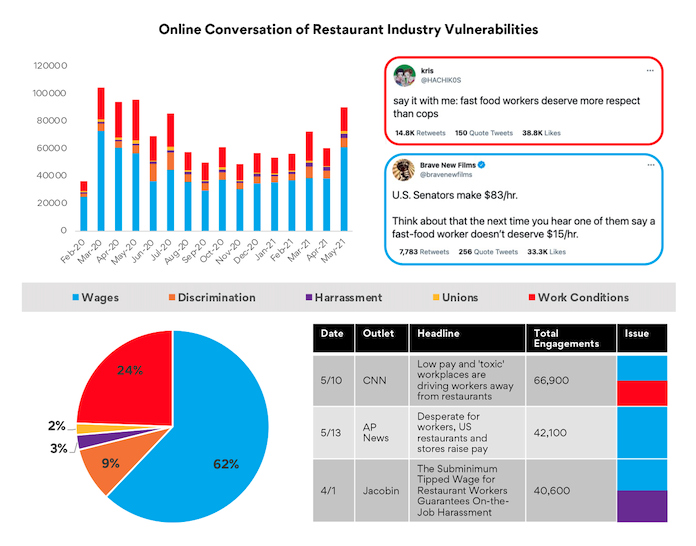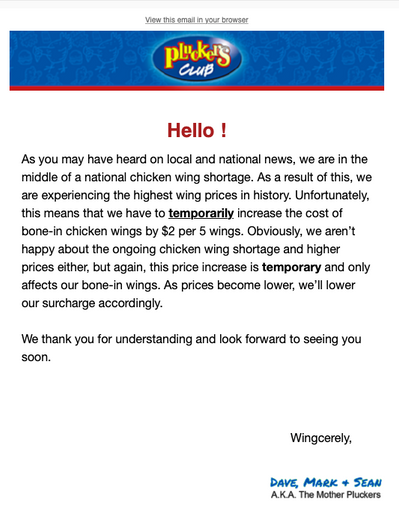The last year and a half have been tumultuous for the restaurant industry.
According to restaurant.org, more than 110,000 eating and drinking places were closed for business temporarily, or for good, and the industry ended 2020 with sales that were $240 billion below the Association’s pre-pandemic forecast for the year.
Now as we enter the summer with over 52 percent of adult Americans fully vaccinated and eager to return to in-person dining with friends and family, the industry is primed for a rebound.
But, alas, there are still lingering issues related to:
- Employee recruitment and retention
- Minimum wage increases
- Ever-changing CDC guidelines around masking, distancing, and sanitation
- Evolving customer expectations
For communicators in the industry – whether they be corporate professionals in large restaurant groups or social media coordinators working for a small family-owned establishment – this new post-pandemic landscape can look like a minefield. One wrong message could set off a bomb that could threaten to destroy the brand reputation of even the most beloved industry establishments. If you don’t believe me, look what happened to Blue Bell ice cream in 2015.
We spoke with longtime industry veteran, Charles “Chuck” Frank on the subject. Frank has over 40 years of experience in restaurant operations and consulting. From owning his own restaurant in Palo Alto to growing the Johnny Rockets franchise into a national brand, Frank has seen it all and believes that effective internal and external communications are essential to maintaining a healthy business.
“In my experience, threats of unionization and labor shortages are typically the result of poor management – leaders that are poor communicators with bad listening skills,” Frank said. “I see this a lot in restaurant chains that are growing fast. Leadership is so focused on opening the next store, that the supporting infrastructure is neglected, and employees bear the brunt.”
When asked his advice for dealing with disgruntled workers, Frank said that “you must listen to them, but be very careful in what you say and do. Make sure to hire a good legal counsel and to have regular meetings – all while being cognizant of NLRB (National Labor Relations Board) rules.”
When we work with companies in the middle of a crisis, we always bring up a famous quote from Winston Churchill: “Never let a good crisis go to waste.” With restauranteurs now exiting the biggest crisis of their generation (Covid-19), now is as good a time as any to reset expectations for their employees, customers, and themselves while using these 3 principles and examples as a guiding light.
Transparency
We asked Frank for the number one thing industry communicators need to do a better job of signaling to their employees and customers.
“Well, one thing we all need to understand is that this is a low-profit business, with most businesses earning 3-5 cents on the dollar,” Frank said. “That’s something your average person on the street fails to understand.”
That’s why it’s important to be as transparent as possible with the costs behind every food item and wage – everything from the price of a tomato to the hourly wage for a busboy. At Vimala’s Curryblossom Café, chef-owner Vimala Rajendran shares profit and loss numbers with her whole staff. It may seem counterintuitive, but she said it can help to foster a sense of ownership amongst the team.
Externally, sharing news about food shortages or price increases can lead to more empathetic customers. Pluckers Wing Bar, a favorite here in Austin, proved this point a few days ago when owners sent an email to customers explaining their reason for increasing the cost of boneless wings by $2 due to a national chicken wing shortage.
Safety Culture
Companies like DuPont Chemicals have a strong safety culture. Before every meeting, they take the time to review procedures in the event of an emergency and point out all the nearest exits. In the food industry, organizations like AC Restaurants in North Carolina deploy a similar technique, but around workplace etiquette. Every meeting in the restaurant starts with a review of the company’s policies around workplace conduct and expectations. Cultural change requires repetition of communication for something to stick over the long term. It also requires a “lead by example” approach, so make sure that your managers are walking the walk.
Mutual Exchange of Value
Much like today’s consumers – who prefer two-way dialogue with their favorite brands rather than being talked at through ads – employees are hungry for a similar exchange with management. Next time you’re with your staff, ask the question: “Who wants a raise?” Then follow that up with “how are you going to earn that raise today, tomorrow, and next week?” That should lead to a brainstorm on how employees can add value to the operation and how the operation can add value for the employees. For this to work, however, employees need to feel like they are heard and that their ideas are being acted on – and even if they aren’t, you should have a good explanation for why.




